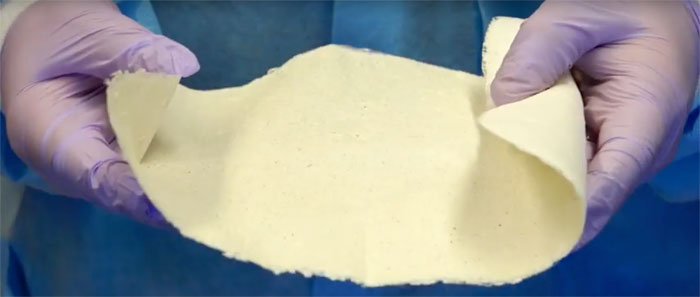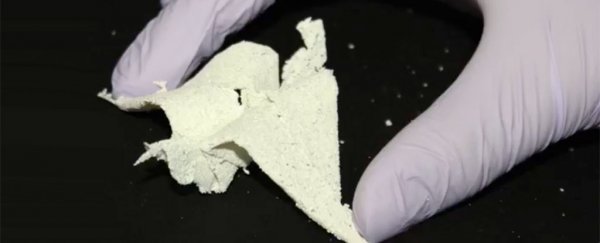Everybody likes playing with origami and making little paper animals, but researchers in the US have taken their hobby to a freaky new level.
Scientists have developed a way of making a kind of bioactive "tissue paper" from real body organs, which is thin and flexible enough to fold into origami animals like the charming crane you see above… which was probably once a kidney, liver, or perhaps a heart.
While it definitely sounds a bit (okay, a lot) on the gross side, this organ origami isn't quite as gruesome as it sounds. For starters, the team from Northwestern University aren't sourcing their tissue paper from human organs – at least, not that we know of.
Instead, the researchers are picking up unwanted pig and cow offal from a local butcher, and putting those discarded off-cuts to good use – because this flexible paper-like material could one day be used to heal wounds, or to help supplement hormone production in cancer patients.
 Northwestern University
Northwestern University
"This new class of biomaterials has potential for tissue engineering and regenerative medicine as well as drug discovery and therapeutics," says one of the team, materials scientist Ramille Shah.
"It's versatile and surgically friendly."
The team stumbled upon the idea for making organ-based paper after a lucky accident during their research on 3D-printed mice ovaries.
A chance spill of the hydrogel-based gelatin ink used to make the ovaries ended up pooling into a dry sheet in the bench lab, and from one strange innovation, another was born.
"When I tried to pick it up, it felt strong," says one of the researchers, Adam Jakus.
"I knew right then I could make large amounts of bioactive materials from other organs. The light bulb went on in my head. I could do this with other organs."
Turning to pig and cow organs, the researchers extracted structural proteins – called the extracellular matrix – from animal ovaries, uteruses, kidneys, livers, muscles, and hearts.
These proteins, which help to give organs their form, were dried and then combined with a polymer to process them into their new paper-like structure.
In other words, it's a bit like papier-mâché with a touch of H. P. Lovecraft thrown in, but what's important is that the paper retains residual biochemicals from its protein-based origins, holding on to cellular properties from the specific organ it comes from.
During tests in the lab, the team was able to grow functional, hormone-secreting ovarian follicles in culture using tissue paper sourced from a cow ovary.
It might only be a lab test using animal organs, but if the same idea could be replicated with human hormone-producing tissue paper implanted under patients' skin, it could be a big step towards treating cancer patients and hormone deficiency generally.
"This could provide another option to restore normal hormone function to young cancer patients who often lose their hormone function as a result of chemotherapy and radiation," explains one of the researchers, Teresa Woodruff.
What could make the tissue paper so easy to apply for medical purposes is its malleability. It feels and folds much like ordinary paper, and can even be frozen for later use.
"Even when wet, the tissue papers maintain their mechanical properties and can be rolled, folded, cut and sutured to tissue," says Jakus.
In addition to hormone treatment applications, the team says the pliable material could augment tissue when wounds are healing, which might be able to speed up recoveries, or prevent scarring from injuries.
Of course, before we even get close to sticking origami organs inside human patients, the next step will be looking into how the paper works in animal models.
But initial signs look promising. When the team put human bone marrow stem cells on the tissue paper, all the stem cells attached and multiplied.
"That's a good sign that the paper supports human stem cell growth," says Jakus.
"It's an indicator that once we start using tissue paper in animal models it will be biocompatible."
To be clear, there's still a lot more research to be done here before we know how viable organ paper really is, but we'll never know unless we try.
And in the meantime, at least one thing's for sure.
"It is really amazing that meat and animal by-products like a kidney, liver, heart and uterus can be transformed into paper-like biomaterials that can potentially regenerate and restore function to tissues and organs," says Jakus.
"I'll never look at a steak or pork tenderloin the same way again."
The findings are reported in Advanced Functional Materials.
